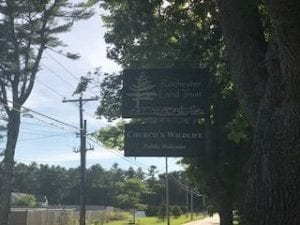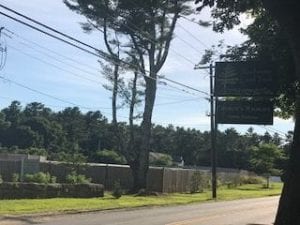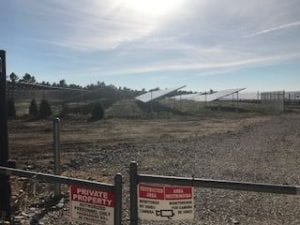Solar energy is one of the many kinds of renewable energies that are gaining major popularity in the United States. Its collector systems are one of the more simple ones to set up, as they are rows of solar panels laid out in an open area (I love wind turbines to death, but they look like a pain to build), and it is clean, and does not require anything that will pollute the air. There are many other benefits for solar energy. However, there are also some issues. Since solar farms require an open area, setting them up may require clearing that space, which often requires the removal of trees. This angers some people, especially those who live in my town, Rochester, Massachusetts. There have been three solar farms installed already, and there are at least seven more are being proposed to the planning board. The town is in an uproar. I, myself, am not impressed either. Don’t get me wrong, I support solar energy as a renewable energy source, and would take it over fossil fuels any day. However, I also support keeping the trees where they are and limiting solar farms in Rochester for the sake of the wildlife, the environment and the property values. Therefore, I’m proposing a complete restructure of Rochester’s solar farm by-laws, using Rhode Island’s laws as a model.
Rochester is a picturesque, rural town. It is known for the natural feel it gives, with its wooded areas, great nature trails, ponds and cranberry bogs. Wildlife is abundant, with turkeys, deer, fox and raccoons which are very common in the area that I live in. The major “commercial zone” of Rochester is Plumb Corner which contains a small convenience store, hair salon and daycare across from the town hall. The people who live in Rochester, especially those who have lived here for most of their lives, have grown accustomed to this small town feeling, and enjoy it immensely. With the continuing proposals for solar farms, however, there is a lot of concern about how the nature of Rochester will change. The main reason that people are angry is that the installment of these solar farms will require acres of trees removed, which would ruin the view and landscape. Rochester wouldn’t feel as natural with a vast array of solar panels. As Ward Benner, a resident of Mendell Road, said to the Sippican Week, “Keeping the trees would be more fitting with the character of Rochester” (Ray).
The installment of solar panels could also have a negative effect on the property values of houses in Rochester. People looking to move to Rochester, with the expectations of a very rural town, will be disappointed at what they would see. According to Ruth Thetonia, the broker/owner of Brook Realty, “Especially in rural areas, people are willing to pay a premium for the view and atmosphere – nature, trees, fields, wildlife. That goes away once a solar farm is built near a residential area. People are not willing to pay a premium for a view of a solar farms and or dirt berms, fencing…” Conversely, having healthy trees can increase property value—larger specimen trees can add ten percent to property value (USDA Forest Service). According to Ms.Thetonia, solar farms are already starting to cause a decrease in property values to current owners trying to sell across from them or adjacent to them. It’s also possible that if these proposals for more solar farms move forward, it would result in less people moving into town. Dale Bindas, a vocal townsperson, predicts that if solar farms continue to be installed, there will see more people moving out of Rochester (Ray). As Rochester planning board member Ben Bailey said, “people don’t move to Rochester so they could look out their window and see a bunch of steel and glass” (Perry).
Wildlife is a major factor to keep in mind, as well. Forests and wooded areas in Rochester provide habitats for many “critters”, such as birds, chipmunks, deer, and squirrels. Removing the trees, or deforestation, to make room for solar farms, would be evicting them from their homes. In general, eighty percent of animals live in forests, and many of them are unable to live through deforestation (National Geographic). The solar panels themselves can be a threat to animals – birds, specifically. Thousands of them are killed every year by large-scale solar farms. The problem is called the “lake effect”, in which birds, and their prey, such as insects, mistake a solar facility for a body of water, hone in on it, and get fatally burnt on the panels (Upton). Rochester has some beautiful birds, like swans, herons, geese, and ducks. It would be heart-wrenching to know that they are getting themselves fried when they think they’re about to take a leisurely dip or have a tasty bite.
The only amendment proposed thus far was to “include a three-hundred foot buffer from any public way, which is three-hundred feet farther than the current zero foot in place now” (Perry). At this time it has not been passed, not that it’s adequate. Massachusetts is a very pro-solar state, currently offering many grants and incentives, up until the year of 2020. However, I propose that Massachusetts should follow Rhode Island’s bill H8141, “which discourages siting solar arrays on large wooded areas by prohibiting state financial incentives for the projects” (Faulkner). The bill was made to create “a balance between a desire to reduce our carbon footprint by spurring renewable energy and still protect our natural resources” (Faulkner). As much as I love solar energy, and what it has done for the United States, I still think that this bill is the right way to go. It would prevent trees from being removed, so that rural towns can retain their natural character, animals can still have their habitats and remain safe, and property values will not go down. I believe that following in Rhode Island’s footsteps would not only appeal to those who oppose the solar farms in place of trees, but it would also save the town a great deal of money. Best of all, the town of Rochester can remain the beautiful, natural and comfortable place it has always been.
Local Land Trust nature trail and wildlife viewing area with adjacent solar farm hidden by stockade fencing. (4 photos)




Entry to local outdoor club with adjacent solar farm abutting the property. (2 photos)


Proposed site for new solar farm requiring removal of acres of trees and installation of solar panels and dirt berms to block view from the road and solar company’s plan for the site.(2 photos)


Rural residence with solar farm directly behind back yard hidden by installed stockade fencing.(1 photo)

Works Cited
“Deforestation and Its Effect on the Planet.” National Geographic, 25 July 2017, www.nationalgeographic.com/environment/global-warming/deforestation/.
Faulkner, Tim. “Solar Power: ‘Clear and Present Danger’ to R.I.’s Forests.” EcoRI News, 13 May 2018, www.ecori.org/government/2018/5/12/bill-protects-trees-and-farms-from-solar-energy.
Perry, Jean. “Board Wants Stricter Solar Bylaw.” The Wanderer, 26 Apr. 2018.
Ray, Andrea. “Residents: Solar Farms Will Affect Town’s Character.” Sippican Week, 27 June 2017.
Thetonia, Ruth. Personal Interview. 7 July 2018.
United States, Congress, “Trees Pay Us Back.” Trees Pay Us Back, USDA Forest Service, Northeastern Area, State and Private Forestry, 2005.
Upton, John. “Solar Farms Threaten Birds.” Scientific American, Climate Central, 27 Aug. 2014, www.scientificamerican.com/article/solar-farms-threaten-birds/.
Revision Reflection:
When I revised my piece on the issue of solar farms in Rochester, the first change that I made, based on the comments, was the format of my citation for the personal interview that I conducted with Ruth Thetonia. I looked on the Purdue OWL website to find this format. At first, I made the citation on Easybib, which is why it looked the way it did. I actually found it was easier to make the citation for the interview in the format that Purdue OWL gave me. I also changed the drop in quote from Dale Bindas to a paraphrase. I then added my stand on the 300 ft. buffer, saying that it wasn’t adequate. I got rid of the sentence that says there is almost always sunlight, considering that’s not true for all regions. Finally, I added some information about the effect that deforestation has on animals from National Geographic.
When reconsidering the draft on my own, I figured that I should make it clear that I’m not completely opposed to solar energy, in general. I believe that it is very beneficial to the environment, because it is a clean source of energy, and can also provide many job opportunities. As a matter of fact, I am looking to become a technician in wind energy, but if all else fails, I plan on falling back to solar. I went ahead and added a sentence saying that I support solar energy as a renewable energy source in the first paragraph, so that it doesn’t look like I am condemning solar energy, and want it to be abolished. I also edited for wordiness, taking out a “that” or two and a few “this is why”.
I also read an article on revision called MAKING MEANING CLEAR: THE LOGIC OF REVISION, by Donald M. Murray. One of the categories he evaluates on when revising a piece is form, and a question that he asks himself is “is the title on point?” I realized that I didn’t even have a title at the top of my page, so I spent some time, thinking of a good title for this piece, and came up with, “Solar Farms vs. Rochester”.